
Retirement planning is a long-term goal. Follow these well chalked out rules that will help you retire early.
Days of joint family era, guaranteed pension, low inflation, assured returns are all but over. Today high salaries, insecure jobs, high inflation, nuclear families are in. But with high salaries, make sure you have planned for your retirement and if you have not, then we will try to shake you out of slumber.
This article meant for Rediff.com readers in mid 20's and early 30's as to first steps to plan for a financially independent retirement life:
1. Find out how much corpus you will be comfortable with at retirement
Most significant thing in retirement planning is to decide upon a correct retirement corpus. Mis-calculating this figure can land you in trouble later. The biggest challenge to your meaningful retirement corpus comes from inflation, which can substantially eat into your savings. Just as compounding works to inflate your corpus, inflation eats into your value.
For instance, a sum of Rs one crore seems a lot of money today but over 20 years, even a low inflation rate of 5% can reduce your corpus to just Rs 35 lakh. So in general, an average Indian investor is not aware of the declining purchasing power of his savings due to inflation. Retirees who no longer earn but depend solely on returns from their investment need to be extra cautious.
If your monthly expense is Rs 30,000 and you retire 30 years from now, you will need Rs 1.8 lakh per month, assuming the annual inflation rate is 6%. Even if you can manage with 80% of your present expenses, that is Rs 24,000, you will need Rs 1.44 lakh every month. In addition if you live till 85 aided by rising living standards and progress in medical science, the corpus mentioned above too is a conservative estimate. 25 years after retirement (assuming you retire at the age of 60 years), the value of nest egg you will need is staggering Rs 4.5 to Rs 5 crore. That is if we assume 6% annual inflation and 12% return on investment before retirement.
If we assume 8% inflation, the corpus required is a mammoth Rs 12 crore!
To calculate money you need for retirement, first calculate your average monthly expense. Let's assume it is Rs 30,000 per month or Rs 3,60,000 per year. Add another Rs 40,000 as miscellaneous expenses and the annual total comes to Rs 4,00,000. If inflation is assumed to be 6% and you expect to retire after 30 years, your annual expense at the time of retirement will be Rs 22.97 lakh. If your investments earn 12% annually in 30 years and inflation is 6%, your effective rate of return is 6%. The corpus required at the time of retirement will be Rs 3.83 crore. Let's assume if you live till 85, you will need close to Rs 6.3 crore.
In nutshell, make sure you have zeroed in on how much corpus you need by the time you retire. Take into account inflation while deciding on the corpus amount. All boils down to your yearly expenditure, inflation expected over the years and standard of living you want post retirement.
Courtesy: Investment-mantra.in

2. Be an early bird
Positive thing among all these huge figures is that if an individual starts early along with a decent jump in incomes over time, expanding career options provides good opportunity to build a sizable nest egg. Early you start better it is. An early start means you will have to save a lot less to create the same corpus. One most common mistake people make is to defer retirement planning till it's very late.
For instance, if a person starts contributing to retirement corpus at the age of 25, the monthly outgo, if s/he wants to build a corpus of Rs 6.3 crore at retirement and if the rate of return is 12% will be Rs 9,700. If s/he starts 5 years later, he will have to save Rs 17,800 every month to build the same corpus.
For most, it means just contributing to Employee Provident Fund (EPF) and Public Provident Fund (PPF) accounts. Either they don't want to spend time to calculate the corpus they will need for retirement or are just focused towards short and medium term goals thinking retirement still is too early to plan.
An early start also gives you freedom to take risks. Equities, for instance has given higher returns than other assets -- gold, debt and real estate -- in the long run. In the last 31 years, equity markets provided a compounded annual growth rate (CAGR) return of 16.85% which is higher than other asset classes. So you can allocate a large chunk of money going into building a retirement corpus in equity or equity related instruments if you start early.
As you approach retirement, you can start liquidating these high risk, high return equity investments and go for safety of fixed income options such as debt funds, bank fixed deposits.

3. Remain focussed throughout for this long-term goal
First thing you need to do while planning for your retirement is to make sure you keep this goal completely separate from your other short, medium and long term goals such as buying a house or child education to name a few. Make sure you keep it in mind that this corpus will be used only when you stop earning. So make sure you estimate the money needed for each financial goal and invest accordingly.
4. Understand where to invest
Make sure you keep it simple and don't invest in products you don't understand. Ensure high-pitched marketing campaigns don't carry you away. Check if the product can give you the desired returns and matches your risk profile. There are many debt and equity oriented financial instruments which can help you build a sizable retirement corpus.
Let's go through different products which can help you build a nest egg big enough to last your lifetime.

a. Mutual funds
Mutual funds can help you if you don't have time and patience to manage your investments in stocks directly. They are considered one of best products due to the sheer variety of schemes that suit every profile, low costs, tax benefits and professional management. Equity mutual funds, which invests up to 100% money in stocks can easily give you 12 to 15% returns an years on an average in the long run. This makes them ideal for those with a high-risk appetite.
Those with slightly lower risk taking ability can go for equity oriented hybrid funds, which invests up to 65-70% in stocks and the rest in fixed income securities such as bonds and treasury bills. Long-term capital gains from equity mutual funds (with over 65% equity exposure) are tax free, making them all more attractive. Those with limited risk taking ability, for instance people close to retirement can go for debt funds, which invest in corporate and government bonds.
Having said that since it's your money, you need to do few things right as regards mutual funds are concerned. A systematic investment plan (SIP) in good diversified mutual funds is a good option for those who wish to build their fund portfolio gradually. It prompts investors to save in a disciplined manner. It also minimises risks of bad timing of investments. Mutual funds offer the convenience of investing small amounts at regular intervals -- daily, monthly or quarterly.
Your portfolio of funds must have an allocation pattern that meets your return objective and is in line with your risk profile. Young investors can have 70% of amount directed to large-cap and multi-cap diversified mutual funds, 20% to mid-cap and small cap funds and rest in gold ETF or sectoral bets. Study the mutual fund closely before deciding to invest in it. Make sure you don't over-diversify and end up having too many funds in your portfolio. Look for AMC, fund size, fund manager performance, objective of fund, sector it invests in and allocation, performance over 10-year, 5-year period, top holdings etc. Avoid investing in NFOs.

b. Public Provident Fund (PPF) and Employee Provident Fund (EPF)
If you want some portion to go in debt, you can look at Public Provident Fund and Employee Provident Fund. PPF is a government scheme under which you get an 8.6% annual return (decided for this year). The minimum investment is 500 per year and maximum is Rs 1,00,000. The money is locked in for 15 years. One can extend the account beyond 15 years in a lot of 5 years and withdraw up to 50% of corpus after the 7th year.
In EPF, one contributes 12% pay (basic plus dearness allowance), while the employer makes a matching contribution. All establishments that employ 20 or more people have to offer this benefit to employees. The rate of return keeps changing and is decided by central board of trustees of the fund every year. At present, it is 9.5%. The money can be withdrawn on retirement or while leaving the organisation.
In the latter case, there is an option to transfer the amount in the account opened with new employer. PPF and EPF investments are deductible from the taxable income under Section 80C. The redemption amount is not taxable.

c. Investing in stocks directly
Besides this you can consider investing in blue-chips stocks, which can give you rich dividends by the time, you close in your retirement. If you can give some more time to equities and try to understand few businesses which can grow by leaps and bounds in coming decade, nothing like that.
Equity SIPs can also be a smart option in volatile stock market conditions such as one prevailing currently.

d. National Pension Scheme (NPS)
NPS is government initiated pension scheme. Under it, you have to contribute at least Rs 6,000 a year in a Tier-I account and a Tier-II account. The money in the Tier-I account cannot be withdrawn till retirement. There are no limits on Tier-II withdrawals. You need an active Tier-I account to open a Tier-II account.
You can choose three asset classes. Asset Class E, where money is predominantly invested in equity and related instruments; asset class C, where money is invested in fixed income instruments and other government securities; asset class G, where the entire portfolio comprise of government securities. Under asset class E, the maximum equity exposure can be 50%. Except central government employees, others can choose any asset class.
Investments are eligible for tax benefits under Section 80C. However the maturity amount is added to income and taxed accordingly.

e. Unit Linked Pension Plans (ULIPs)
Unit linked insurance plans combine features of insurance and investment products. A part of money gets you a life cover while rest is invested in equity or a mix of equity or debt. ULIPs as compared to mutual funds have multitude of charges -- allocation charges, policy administration charges, fund management charges and morality charges. Hence, they are considered more expensive than mutual funds.
However, ULIP pension plans are pure investment vehicles. Since there is no insurance cover, the investor can save on mortality charges. Since IRDA has issued guidelines as not to give guaranteed returns in ULIP pension plans, the companies play it safe and invest more in debt. This make ULIP pension plans less attractive to those seeking high returns.
Investment in ULIP pension plans is eligible for tax deduction under Section 80 C of the Income Tax Act. The maturity proceeds are tax-free. The tax benefits are likely to continue under Direct Tax Code, proposed to be implemented from next year which will take other ULIPs out of Section 80C.


5. Find out the investment options for different age groups
Make sure as you approach retirement, you should increase exposure to less risky investments as the number of working years is less and you have to protect your corpus from the vagaries of the equity markets. Therefore you may need to re-balance your portfolio as you cross different age groups. There is no strict demarcation, though, as investment portfolio is a function of one's risk taking ability, existing investments, income, expenses and financial goals. Still one can evaluate four different portfolios for four different age groups: 18 to 25 years, 25 to 35 years, 36 to 45 years and 46 to 55 years.
a. Age 18-25 years
This is the time when you start your career and have no liabilities and dependents. Though your income is less, but so are your expenses. You have time on hand and can afford high exposure to equities. Ideal portfolio can be close to 85% equity, 10% debt and 5% gold.
Make sure you park adequate money in a savings account or a liquid scheme for any medical or financial emergency. You can invest in equity mutual funds through SIPs as it makes you more disciplined. You can have exposure to stocks under proper guidance. You can defer your goals for buying a car or house for some time as your current income don't allow you to invest in these. However you can start investing in small amounts for your retirement.
Make sure you have adequate health insurance so as to take care of any medical emergency. If you don't have any dependents, you don't need any life insurance currently. You should focus on acquiring more skills at work so as to increase your income substantially going forward.

b. Age 26-35 years
Your income increases and so do your liabilities. You are still far from retirement and can have high exposure to equities. Since you have more liabilities now, make sure you have exposure to fixed income instruments for a cushion against volatility in equity markets. Make sure you start contributing to PPF and EPF as part of your debt allocation.
You can have equity: debt: gold in the ratio as 75: 15: 10.
You can go ahead and buy a term life insurance policy with a cover that takes care of your liabilities, your future income generation potential etc.
Make sure you create a contingency reserve based on your monthly expenses for 3 to 6 months and keep it aside. Besides this continue your investments in SIP and maybe increase its allocation as your salary increases. See if you need to enhance your health insurance cover and have a family floater plan in place.

c. Age 36-45 years
Your liabilities increase faster than income. Hence scale up your investments in PPF and continue with EPF. Equity can still continue to be 65% of your portfolio while debt and gold accounting for 25% and 10% respectively. This is the time when one's earning graph moves upwards and the same should hold true with investments. Also evaluate again your life and health insurance cover and see if you need to enhance both of them.
d. Age 46-55 years
Continue with your investments in equities though you can scale it down to 50% and increase debt exposure to 40% (debt instruments such as PPF, EPF, debt mutual funds, bank and corporate FDs). Keep investing in gold at 10% allocation.
Your priority should now start shifting slowly towards protecting your already built retirement corpus from equity market volatility. At this stage of your life, you may need to enhance your medical cover. Focus more on paying off your debt and liabilities for a peaceful retirement.
Earlier you plan for retirement, better it is as it gives much more time for your money to grow (power of compounding). In addition in today's age, people want to retire early so as to pursue one's hobbies. So there is a double challenge for a shorter horizon to save for retirement and a longer period of withdrawals. Next, improvement in health care facilities especially in urban areas have pushed life expectancy in India. Since you live longer, you need to save more....